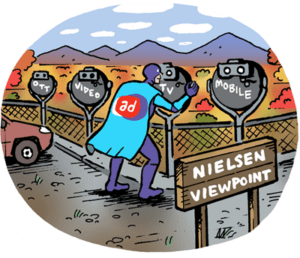You can stop holding your breath: Phase one of Nielsen ONE is finally complete.
On Wednesday, Nielsen announced that Nielsen ONE Ads, the first module of its cross-screen measurement platform Nielsen ONE, will be available starting January 11.
Nielsen ONE sits at the heart of Nielsen’s strategy for competing with the many alternative measurement currency providers that rushed the stage after Nielsen lost its accreditation from the Media Rating Council for local and national TV ratings in late 2021.
And the explosion of AVOD last year has only made audience-based measurement more urgent for Nielsen’s business, said Kim Gilberti, Nielsen’s SVP of product management, during a press briefing on Tuesday.
Nielsen first started alpha testing its revamped measurement solution in December 2021 with a planned release for December of last year. Considering more than half of Nielsen’s senior management team left the company just two weeks ago after an internal business reorg, Nielsen didn’t miss its self-imposed deadline by much.
As the old adage goes, the show must go on (and be accurately measured). But how will Nielsen hold its own as a currency against all the fresh competition?
Work in progress
Broadcasters and buyers spent most of 2022 panning panels as a stand-alone measurement currency, even if they’re still helpful for specific use cases.
It became imperative for Nielsen to start shifting toward impression-based measurement so its metrics are compatible across linear and digital channels.
Over the summer, Nielsen launched a four-screen ad deduplication tool that added CTV to the different screens, against which marketers can buy deduplicated audiences. (The other three are linear TV, mobile and desktop.) Nielsen also introduced Nielsen ONE Content last year, which provides a more aggregate view of campaign performance across devices. Nielsen ONE Content remains in alpha, but will be available later this year.
The Nielsen ONE Ads dashboard will allow advertisers to track deduped audience reach and frequency counts, including a percentage of target audience reach, across screens by campaign based on Nielsen’s panel data and its ID resolution system, which it launched in early 2021. This data will also be available for buying and selling.
Although Nielsen ONE Ads is squarely focused on campaign measurement for now, Gilberti said, Nielsen intends to add more and different types of data to the Nielsen ONE platform over time.
Nielsen will also provide linear campaign reporting at a second-by-second level, rather than just by the minute, so as to make its linear metrics more comparable with digital and streaming.
Gilberti refers to this second-by-second data as “impact data” because it’s for research and planning purposes only, and isn’t available for buying and selling yet.
Nielsen also plans to use its people-based audience panel to calibrate big data sets from set-top boxes, smart TVs and third-party data partners – a move in step with the changing role of TV panels from a tool for audience measurement to a tool for verifying large data sets. Data within Nielsen ONE Ads that includes big data sets is also “impact data” for planning, but not available for buying (yet).
And, because it’s been collecting panel data for 100 years, Nielsen has an edge over alt currencies, Gilberti argued, because it can help account for co-viewing by personifying an impression.
The objective of Nielsen ONE is ultimately to “associate TV viewing with people, not just devices,” she said.
But the competition is fierce, which means Nielsen will need to keep adding features to ONE.
Later this year, Nielsen will launch advanced audiences and outcome-based measurement as part of the platform, both of which have been big asks from publishers and advertisers.
















